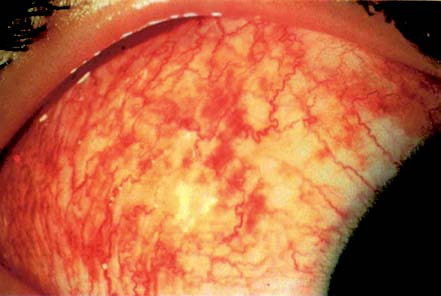Epidemic hemorrhagic conjunctivitis (EHC) is an explosive outbreak of a self-limiting ocular infectious disease caused by enterovirus type 70 (occasionally by coxsackievirus A24). It is also referred to as "Apollo 11 conjunctivitis." The onset is sudden, with marked symptoms of irritation.
Clinical Manifestations
The incubation period is short, typically lasting 18–48 hours, and the disease course is generally 5–7 days. Common symptoms include ocular pain, photophobia, a foreign body sensation, tearing, subconjunctival hemorrhage, and eyelid edema. Subconjunctival hemorrhages may appear as pinpoint or patchy areas, initially affecting the upper bulbar conjunctiva and gradually spreading to the lower bulbar conjunctiva. Most patients exhibit follicle formation, accompanied by epithelial keratitis and preauricular lymphadenopathy.

Figure 1 Epidemic hemorrhagic conjunctivitis
Subconjunctival hemorrhage presenting as pinpoint or patchy areas.
Diagnosis
Diagnosis is based on the characteristic symptoms of acute follicular conjunctivitis, along with notable findings such as subconjunctival hemorrhage and preauricular lymphadenopathy. Viral isolation, PCR testing, or serological examination can aid in confirming the etiological diagnosis.
Treatment and Prevention
There is no specific treatment for EHC, as it is self-limiting. Symptomatic relief is the main approach, using locally applied broad-spectrum antiviral agents, such as interferon eye drops or ribavirin eye drops. Maintaining good personal hygiene and proper hospital management are key measures to prevent the spread of the disease.